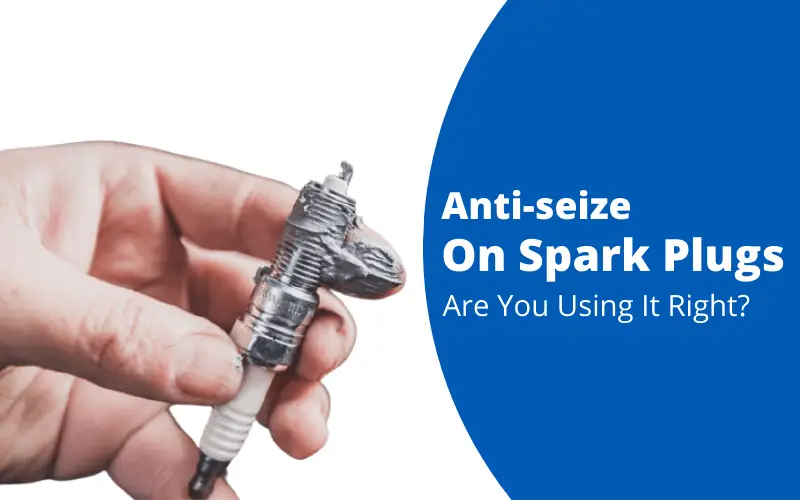Anti-seize lubricant or grease decreases the torque value of a bolt or fastener by approximately 20%. As a result, rust or any chemical can’t damage the threads or make disassembling that bolt or fastener tough.
The intention for using anti-seize on spark plugs is no different. Now, let’s talk about why seizing happens, which type of plugs need it, how much you should apply, and how to apply.
Why Does A Spark Plug Seize?
You know that speak plugs help ignite the fuel mixture. Due to the combustions, the plug is always exposed to extreme heat. That is the reason for its rapid deterioration.
Furthermore, a bad engine is also equally responsible. It results in carbon buildup which is the biggest enemy to a spark plug. The area of carbon deposit is around the tip of the plug. When you try to remove the plug, the extra layer of rust or carbon prevents it from coming out. Thus, it is called a spark plug seizure.
Another reason for seizing is corrosion which rarely happens in modern engines. However, engine fluid or water on the outside can also affect the top part of the plug. As a result, the threads decay over time and prevents the plug from coming out.
How to Prevent Your Spark Plugs from Seizing?
ensuring several things, you can prevent a seizing from occurring. The first and most important task is to take care of the engine regularly. As different spark plugs have different ways to be installed and removed, it is the best practice to let a professional look into it.
Furthermore, you should replace the engine oil and air filter regularly. Also, don’t go for any low-quality fuel.
Next, you can do a light coating of dielectric grease on the top part of the plug to prevent moisture from reaching the bottom part. Moisture can introduce rust, and cause seize before you can realize.
Finally, make sure that the plug and its thread are dry and free from any fluid before installation. Using an anti-seize product is also a solution but you can’t use it on any plug. Let’s talk about that in detail.
Which Type of Spark Plug Needs Anti-Seize?
One needs to either check the owner manual or service manual to know whether the car’s spark plug needs anti-seize products. If you are considering an aftermarket parts manufacturer’s plug, check their recommendations.
For example, NGK Spark plugs strongly recommends not to use anti-seize because their spark plugs come with a special coating. In such cases, going against the recommendations might increase the torque count. The significance of it is that you might over-torque the spark plug.
When you see a plug that is not from NGK, you should check whether it has a chrome-plated thread. You can know by seeing a silver finish. Here, you must not use anti-seize as it is already treated to deal with any situation.
However, if you see a product with a black oxide finish on the bottom part, it will be okay to use anti-seize.
Now, can you put any amount of lubricant or grease? No, you can’t use too much loosening product can cause damage to the thread. Read the next part and it would be clear to you.
How Much Should You Use?
One should do only a single thin light coat of the grease on a spark plug. Too much product can go down to the spark area and cause problems. That is why most of the manufacturers recommend against it.
Note: If you are not familiar with the feeling when a spark plus is tight, you may over-tighten the anti-seize-applied plug causing more damages. So, take the help of a technician.
How to Apply Anti Seize on Spark Plugs?
- Firstly, take a cotton swab, and put some anti-seize grease on it.
- Secondly, apply it on the thread of the spark plug gently and evenly.
- Then, cover only the middle part leaving the bottom two or three threads dry.
- Finally, clean excess grease, and install the plug carefully.
Conclusion
The debate for using anti-seize on spark plugs is going for a long time. And some even expert mechanics make the mistake of using the lubricant on the wrong plugs. I hope that you now understand where to use it and how much.
But if you have even the slightest confusion, you will need to consult with your mechanic. You can also leave a comment describing your issues, and I will try to solve them as fast as possible.
More to explore:- How to tell if you Need New Spark Plugs
- Can You Use Dielectric Grease On Spark Plugs?
- Best spark plugs for chevy cruze 1.4 turbo
- 4 Best Spark Plugs for f150 EcoBoost
- Best Spark Plugs for 4.7 Dodge Ram
- Best Spark Plugs for 5.7 Hemi
- Best Spark Plug Wires For Chevy 350 With Headers
- Best Spark Plug Wires for 5.3 Silverado

